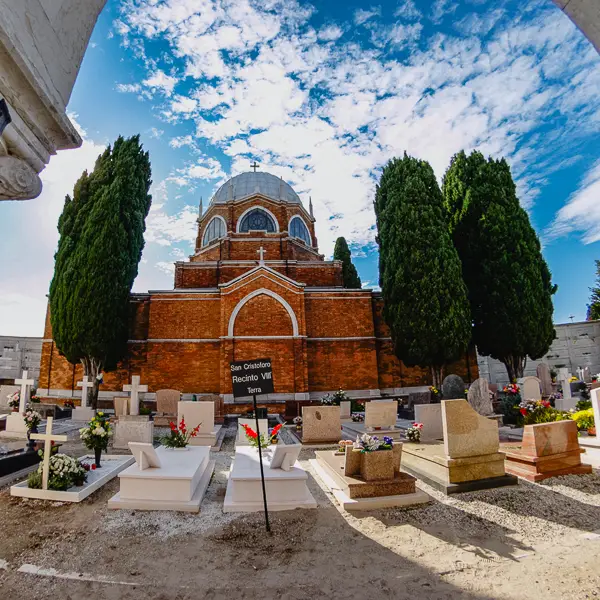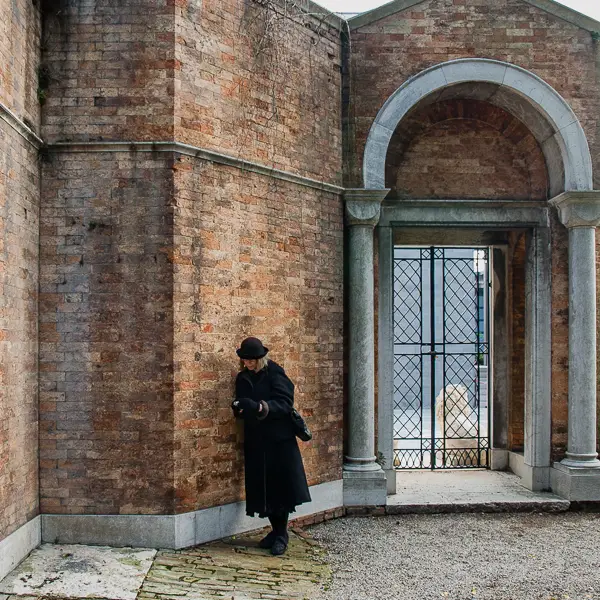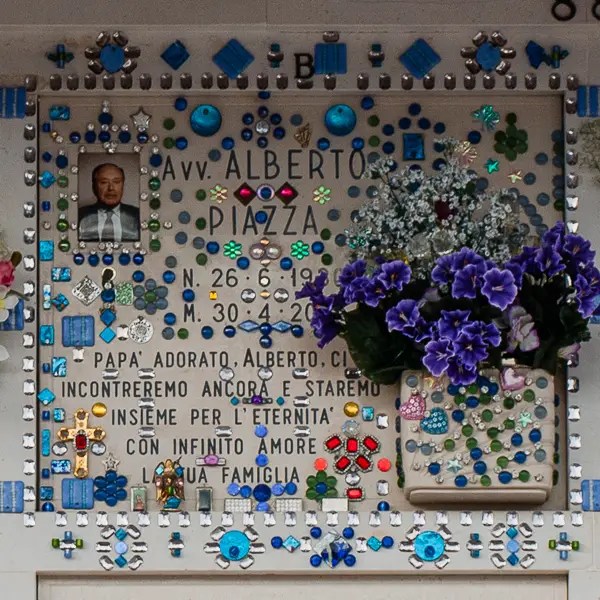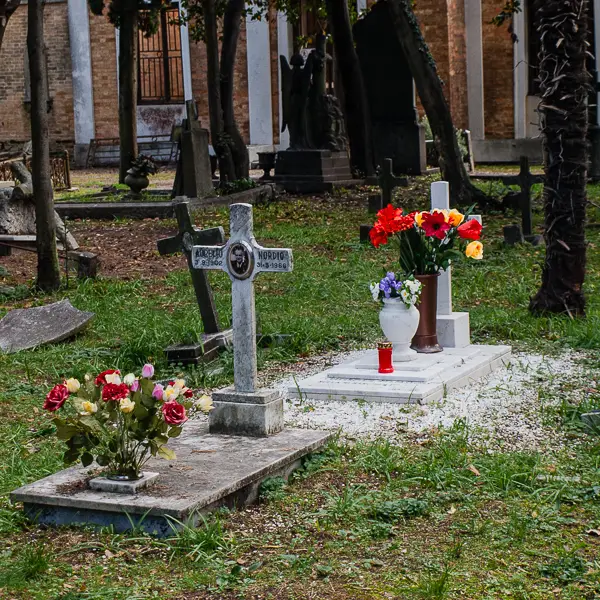|
|
| Venice Home | All topics |
| Where to stay | Transportation |


|
|
San Michele CemeteryTo Die in Venice: The Venetian Lagoon's Island Graveyard
ABOVE: A public water bus approaches the cemetery island of San Michele in the Venetian Lagoon.
When the Piazza San Marco has more tourists than pigeons and the No. 1 vaporetto is wallowing under the weight of its passengers on the Grand Canal, there's one place in Venice where the crowds are quiet and unobtrusive: the Isola di San Michele, a former prison island that is only five minutes away by water bus. San Michele is Venice's cemetery--a role it has borne with dignity since the early 1800s, when Napoleon's occupying forces told the Venetians to start hauling their dead across the water instead of burying them all over town. A cruise ship for the departedIn The World of Venice, Jan Morris compares the cemetery island to a ship where "the director stands as proudly in his great graveyard as any masterful cruiser captain, god-like on his bridge."  ABOVE: San Michele has two churches. This one is the Chiesa di San Cristoforo. Morris continues:
Walls separate the various areas, and the graves lie in neat (if tightly packed) rows that are separated by walking paths for the convenience of mourners and visitors. Here and there, the path leads to a border of contiguous marble-topped crypts that must be traversed to leave the garden. ("Is it okay to walk on the tombs, honey?" "I dunno. But we're wearing our rubber-soled shoes, so maybe the caretaker won't notice.") Segregation by sect
ABOVE: After a dozen years of burial, remains in the Catholic section of San Michele are transferred from their original graves to metal boxes that are interred in outdoor mausoleums.Most of San Michele's acreage is reserved for Catholics--a fact that's hardly surprising in a country where Roman Catholics, practicing or otherwise, make up the vast majority of the population. In Venice: The Art of Living, Frédéric Viteaux describes the Catholic cemetery during All Saints' Week:
ABOVE: Family members tend graves in one of the Catholic sections of San Michele. The island has two mini-graveyards for other Christian sects: the Greci or Greek Orthodox cemetery, where Igor Stravinsky and Sergei Diaghilev are buried; and the Protestant graveyard, whose most famous resident is Ezra Pound. (Jews have their own cemetery on the Lido, Venice's resort island.) In contrast to the formal and beautifully tended Catholic gardens of graves, the Greek Orthodox and Protestant sections have an atmosphere of rustic decay. Some tombstones are covered in moss; a few lean at precipitous angles; several have keeled over in a parody of those whose deaths they commemorate. The occasional English epitaph reminds visitors of a time when the British upper classes regarded Venice as a home away from home. The most famous inscription honors a Staffordshire man who was said to have "Left us in peace, Febry 2, 1910." "Your checkout time is 2037"
ABOVE: A woman carries a watering can past a wall of funerary niches. Death may be permanent, but San Michele is so crowded that graves are on short-term lease. In the Catholic section, the bodies in each row of graves are allowed to decompose for twelve years, at which point they're dug up. Occupants whose families can pay for reinterment are transferred to small metal boxes for permanent storage in mausoleum niches. The less well-heeled get tossed into a nearby boneyard. In the old days, bones were dumped on the ossuary island of Sant'Ariano, which Michael Dibdin describes in his novel Dead Lagoon:
How to reach San Michele
ABOVE: An ACTV Line 4.2 water bus from Cimitero approaches Fondamente Nove in early evening. The walled island of San Michele is visible across the water. If you're dead, the undertaker will deliver you to the cemetery by aquatic hearse (or by funeral gondola if your survivors have a flair for the dramatic). For a more temporary visit from central Venice, catch ACTV water bus Line 4.2 at Fondamente Nove (platform B) along the northern edge of Venice's historic center. Get off at the next stop, Cimitero, after a 7-minute ride. If you're going to San Michele from the glassmaking island of Murano, catch the Line 4.1 boat to Cimitero at any of several Murano waterbus stops. (Cimitero will be the first stop after the boat leaves Murano). ACTV boats run several times an hour during the day and early evening. For schedules, use the links in our ACTV Maps and Timetables article. Also see our Venice Local Transportation index for articles on vaporetto fares, tourist passes, ACTV's new "tap to pay" electronic payment option, etc. Note:
More photos:
ABOVE: L'Isola di San Michele is surrounded by a brick wall with iron gates spaced along the island's perimeter.  ABOVE: Cheryl Imboden stands inside the cemetery near one of the island's gates, which provide views of the Venetian Lagoon and central Venice.
ABOVE: A man and a woman use a ladder to place flowers on a mausoleum niche in San Michele's Catholic section. 
ABOVE: The niches in San michele's outdoor mausoleums are often decorated with photos, flower vases, and other items. This niche is covered in glass mosaic.
ABOVE: A plaque marks the entrance of the Reparto Evangelico, a.k.a. the Protestant Cemetery. 
ABOVE: The Protestant section of San Michele resembles an English churchyard.
ABOVE: San Michele's Protestant and Greek Orthodox cemeteries have an atmosphere of benign neglect, but vibe is pleasant and the occupants certainly aren't complaining.
ABOVE: This columnar tombstone is from 1905. It identifies the graves of two brothers from Switzerland.
ABOVE: A statue of an angel stands above the grave of Emmy Amelm Mowicki, a child who died in 1908.
ABOVE: Another grave is marked by a sentimental poem.
ABOVE: The grave of Franz Herrmann, who died in 1892 at the age of 12, has a seemingly random statue of an older gentleman sitting beneath its wall-mounted marker.
ABOVE: A tombstone in the Protestant Cemetery commemorates Archibald Campbell, master of the sailing yacht Minerva, who died on board his vessel in 1891 and was interred at San Michele.
ABOVE: A German farewell marks the grave of an unknown guest.
ABOVE: A pair of ballet slippers and a straw hat adorn the tomb of Sergei Diaghilev in the Greek Orthodox cemetery at San Michele. (Diaghilev was a Russian impresario and arts philanthropist who founded the Ballet Russes in 1909.)
ABOVE: The American poet Ezra Pound is another of the island's celebrity residents. (Pound died in Venice in 1972.)
ABOVE: Although Joseph Brodsky was Jewish, his grave is in San Michele's Protestant section. Brodsky, a Russian-born American poet and essayist, received the Nobel Prize for Literature in 1987.
ABOVE: This grave belongs to John Harris, who was the U.S. Consul to Venice from 1870 to 1881.
Permanent Italians, a trade paperback by Judi Culbertson and Tom Randall, has a chapter on the late and the great who are buried or entombed in Venice.
|
|
| Venice for Visitors - Home | | Europe for Visitors - Home | | About our site | | Press clippings | | Testimonials |
Disclosure: Where hotel or other reservation links point to third-party booking sites, we may receive a small commission on transactions. This will not affect the rate you pay. Copyright © 1996-2025 Durant and Cheryl Imboden. All rights reserved. |